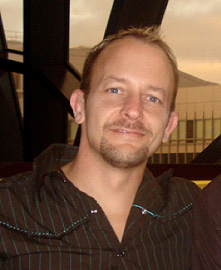4Dancers.org readers can download free music by Cory Gabel. Click here.
By now readers know that I am very much a fan of talking about music for dance. To that end, today we have Cory Gabel with us to talk about how an original piece is created for dance from his point of view…the music side!
1. Can you tell readers how you got involved with making music for dance?
Around 2002, I was transitioning out of my alternative rock band Limestone Rome. I moved into instrumental music and writing scores for film. Around that time I caught a great Pilobolus performance where they integrated all kind of modern rock, alternative, techno, electronica – all the styles I like to work in. Seeing the power of that music with dance a light bulb kind of went off – why don’t I write original music for THAT?!

2. What is your music like?
It’s such a cliche to say that’s it’s hard to categorize, but it truly must be – iTunes seems to put every release I come out in a different category! As far as musical styles, I combine elements of modern orchestral, industrial rock, electronic dance music, usually aiming for a fairly large, theatrical or epic sound. I always like to contrast those thick sonic textures with very minimal, simple sounding melodies of solo strings, piano or vocals. When my music gets reviewed or commented on, I often hear comparisons to Trent Reznor, Philip Glass, Moby, Danny Elfman and others.
3. What is the process of making music for dance like?
It really varies depending on the project and the nature of the collaboration. For more theatrical pieces, I may actually get involved with the development of the story, working with the artistic director to sketch out the acts and pieces and determining what styles and tempos of music will work for each. For pieces that are more thematic, the choreographer usually has an idea of what they’re looking for, and may even already have some music they’re working with. We talk about what is and is not working with what they have, really aiming to uncover the emotional core of what they’re trying to convey.
I almost always work remotely – so it’s lots of correspondence via phone and email – I send music as it develops, they send me back videos from rehearsals. It actually works very well!
4. What special considerations are there when working on projects such as these?
It’s recognizing that for the music to work at its best, it needs to be completely married to the dance that will be happening with it. Film music is meant to be felt emotionally, but not necessarily heard. Pop and rock music are their own sole attraction. But music for dance works when you really can’t imagine one without the other. I think that’s why many of the people I’ve worked with want to continue our collaborations – it’s hard to go back to picking out CDs and other music that weren’t written to perfectly compliment their choreography once they’ve seen how cool that can be!
5. What are the greatest challenges?
It seems increasingly hard for ballet and dance companies to commit to completely original works, I’m sure much of which is financial. Additionally, the idea of creating all new music, choreography, costumes, lighting, can seem a bit ambitious for many companies (and their boards!). So – navigating through all the conversations to get to the point where everyone says “let’s do it!” – that’s actually the challenge. In my experience, however, I’ve yet to have a project where everyone involved didn’t feel it was both creatively and financially successful at the end.
I absolutely love tech and dress rehearsals. It’s at that point that I finally get to see how the music that I’ve written and produced has also been the foundation for dozens of other creative people – dancers, choreographers, musicians, designers- to work their craft. Plus, I’m a junkie for the buzz before any kind of live performance – the nerves, the glitches, the last minute changes – that’s very much part of the thrill!
7. What’s next for you?
I’m collaborating again with Gregory Hancock Dance Theatre in Indianapolis, we’re going to re-stage and expand The Casket Girls (originally premiered in 2009) for Halloween 2013. I just completed Water Wars with Sonia Plumb Dance, and we’re also talking about a new production for 2013. I’m always having conversations with potential collaborators, which I can’t announce just yet, but I encourage dance companies of any size to reach out – I’d love to hear about your ideas for new works!
4Dancers.org readers can download free music by Cory Gabel. Click here.
The following clip is an excerpt-mix of nearly 20 original pieces written for dance by Cory Gabel.
[soundcloud id=’39342032′ artwork=’false’]





